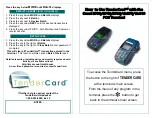
location for the Base Station. The site survey evaluates the signal strength of a number of test packets that are
exchanged between the Base and Terminal. The higher the number, the more successful your communications
will be from that area. This helps you to identify problem areas before you implement your RF Terminal
system. At 30 ft., this is also the acid test for suspected bad radios in a base or in a terminal.
Let’s start with a discussion of the basic theory behind a
Two-Way
RF Terminal system.
How the Two-Way RF System works
Basic RF System communications…
The RF system consists of three components –
Host Computer
,
Base Station
and
RF Terminal
. The
Base
Station
connects to the
Host Computer
via the serial port. The application running on the
Host Computer
sends a data prompt to the com port where the Base Station receives it. The
Base Station
then transmits the
data prompt via radio frequency to the intended
RF Terminal
. The
RF Terminal
displays the data prompt on
the display and waits for the operator to enter the requested data. Once the operator enters his data, the
RF
Terminal
transmits the data to the
Base Station,
which in turn passes it on to the
Host Computer
. The
application on the host computer processes the information and sends a new data prompt out to the
Base
Station
and the whole process begins again.
A little more in depth…
This RF system’s dialogue is Terminal initiated. The Terminal says, “I’m here, give me something to do.
The Worth Data RF system is different from other systems in that our RF Terminal does not constantly
“listen” for a data prompt from the host. We decided to use a different approach that would help to eliminate
unnecessary radio traffic, conserve battery power, reduce the size of the Terminal, and greatly simplify the
operation.
Here is how it works:
Each RF Terminal has a unique
Terminal ID
. When the RF Terminal powers up, it asks if you want to
SIGN
ON?
Pressing YES at the
SIGN ON?
prompt causes the RF Terminal to transmit it’s
Terminal ID
and a
byte of data
indicating to the Base Station that it wants to sign on to the system.
When you press YES to the
SIGN ON
prompt on the RF Terminal, the Terminal will display the following
message:
WAITING ON BASE TO ACKNOWLEDGE
This message is normal when first establishing communication and may occur occasionally during normal
operation.
When the Base Station receives a
SIGN ON
message from a RF Terminal, the Base Station transmits the
SIGN ON information to the host computer. The host computer application can then do one of two things:
•
If it has something for the Terminal to do, it can send a prompt to the Base, which in turn transmits it to the
Terminal. The RF Terminal receives the prompt, waits for the operator to enter the requested data, and then
transmits the data back to the Base Station.
•
If the host program does nothing within an allotted time, the Terminal displays the message:
WAITING ON HOST PROMPT
Lets suppose that a RF Terminal and a Base Station have been processing data by sending prompts and data
Summary of Contents for 7000 Series
Page 1: ......
















































